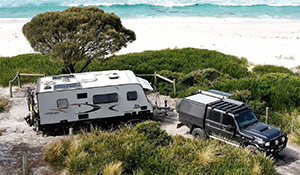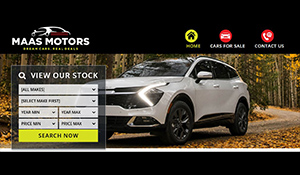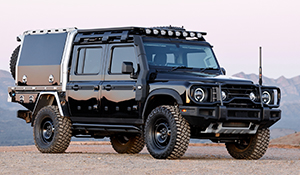1988 Ford Maverick Model Review
The Ford Maverick was released in early 1988, but unlike most new 4WD launches, the Maverick's arrival on the 4WD scene was accompanied more with confusion, than excitement. The Maverick, after all, had been running around our roads for quite some time as the GQ Nissan Patrol. The only real differences were the change of manufacturer badges and some reworked specifications. The Maverick was totally built by Nissan, and while badge-sharing is certainly not new in the automotive business, was a bit hard to swallow for many die-hard Ford enthusiasts.
Holden had done the same thing with the rebadged Suzuki - as the Holden Drover - and certainly the original Willys Jeep and Ford GP Jeep were an early example of building 4WDs to the same specs, but with different badges. For Ford, the adaptation of the roomy Nissan 4WD wagon into their stable was an important step, as Ford's presence in the 4WD arena was rapidly fading. Apart from the bigger F Series utilities, Ford did not have a model in the family recreation market, or a commercial one tonne workhorse.
Models
The Maverick line-up encompassed the complete Nissan range from cab chassis, through to long wheel base wagon and short wheel base hardtop. In fact the Maverick range was greater than Nissans, offering a basic wagon in either petrol or diesel, through to a top of the range XLT hardtop. There were nine variants in the range, with buyers having the choice of three body styles, three equipment levels and petrol or diesel power. The model range included five with diesel and four with 6-cylinder 4.2 litre petrol engines. The petrol models consisted of a standard wagon, and XL wagon, and XL hardtop and a top-of-the range XLT hardtop.
The cab chassis and pickup variants were only available with the 4.2 litre diesel. The 4.2 litre engine was standard and produced 125kW of power at 4200 rpm and 325Nm of torque at 2800 rpm. The 4.2 litre diesel developed 85kW of power at 4000 rpm and 264Nm of torque at 2000 rpm. The seven models in the wagon and hardtop range were offered with choice of diesel or petrol powerplants. They all featured coil suspension. The Maverick was offered in three trim levels: Standard, XL and XLT, the latter only available as an SWB hardtop.
Standard trim was only available in the wagons. The entry level models were equipped with limited slip differential, power assisted front wheel disc/rear drum brake combination and power steering. Coil springs all round provided a great ride, with a rear anti sway bar standard, rather than the retractable system used on the top line Nissans. Rear wheel travel was in the order of 250 mm, and around 220 mm up front. The top of the range XLT hardtop was a top performer with gutsy 4.2 litre engine and five-speed manual transmission. Unlike the other models, the XLT also received a rear differential lock as opposed to the limited slip diff offered in the standard and XL models.
The level of interior appointments was adequate in the standard, with vinyl cab trim and floor covering, and cloth trim seats. The XL Maverick wagons and hardtops had full instrumentation including tacho, oil pressure, water temperature and battery voltage gauges. An AM/FM radio/cassette, twin speakers, carpet, cloth trim and bucket seats in the front offered high comfort and convenience levels. They were fitted with 215/80R 16 radials on spoked rims, which were an improvement over the standard model. The XLT trim level was further improved with 7 x 15 styled steel wheels with 10R15 Desert Dueler tyres, which fitted under large flared guards.
Alloy side rails were also standard. Inside, the interior featured a tilting sun roof, power windows and central locking. Better bucket seating, and a higher grade AM/SW/FM radio/cassette, with four speaker system, and electric aerial were standard. The major addition to the dash was a vacuum-operated switch that was used to operate the rear differential lock.
Ford/Nissan split
Like many good relationships, there came a time to walk away from the model sharing arrangement, and for Ford/Nissan this occurred in 1993. This involved not only the Ford Maverick and Nissan Patrol, but also the Ford ute badged as a Nissan utility, and the Nissan Pintara, which was badged as the Ford Corsair! The 4WD arrangement was a stop gap deal which suited both companies at the time. Ford in the meantime was trying to source another 4WD and a four cylinder sedan car.
Over its six-year life, the arrangement saw around 13,000 Mavericks sold, with the Nissan equivalent selling around 33,000 in the same period.
With Ford in USA converting their Ford Explorer 4WD to right hand drive, and news that it was due in Australia the following year, this was the 4WD that Ford had long been awaiting. The Maverick was a good vehicle and while the manual version was probably a better performer in off-road conditions, suited many new four-wheel drive enthusiasts. For a young couple or singles, the XLT SWB hardtop was hard to beat. Despite the higher profile of the Nissan GQ, the Maverick managed to carve its own market niche, with many prepared to stick with brand loyalty and buy a Maverick rather than a Patrol. As a result, Ford can be happy with their efforts in marketing and promoting the Maverick as a member of the Ford family.
Brian Tanner









